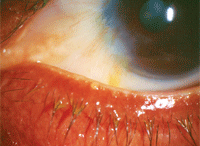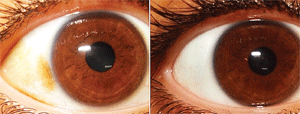A 34-year-old black man presents for an evaluation complaining of chronically red eyes that have persisted for the last 10 years. “Doc, I don’t know what to do,” he says. “My eyes are always red. Everyone asks me if I was out late last night or doing something that I’m not supposed to be doing. I’ve tried those drops that are supposed to ‘get the red out,’ but they don’t help at all. Is there anything you can do? The last doctor I saw told me I’d just have to live with it.”

Slit lamp evaluation shows dense racial melanosis in both eyes, as well as excessive, dilated vessels throughout the conjunctiva. His corneas are clear and the chambers are deep and quiet O.U. There is no sign of allergy, infection or inflammation of the lids or ocular surface. His intraocular pressure measured 14mm Hg O.U. The fundus examination is unremarkable.
Unfortunately, we’ve all seen patients like this. Many individuals seek help for eyes that are chronically red and appear inflamed. In some cases, the conjunctiva may not even be hyperemic upon closer inspection, but rather just darkened due to racial melanosis. Yet, the social implications of eyes that are discolored can be quite significant, especially for those whose livelihood depends on face-to-face interaction. The assumptions and perceived biases can be substantial, because observers often assume that these individuals are sick or otherwise “impaired.”
Until recently, however, there really was very little that could be done for patients with chronically discolored eyes. Topical lubricants, vasoconstrictors or antihistamines––whether prescribed or self-initiated––provide limited success, but rarely eliminate the problem. But, over the last several years, a small cadre of elite surgeons have pioneered the field of cosmetic eye whitening. Seriously, just type the words “eye whitening” into Google, and your first hit will likely be for Dr. Brian Boxer Wachler’s patented I-BRITE system.
Dr. Boxer Wachler, a fellowship-trained refractive and corneal surgeon who practices in Beverly Hills, is a source of comfort and relief for individuals who are unhappy with the appearance of their eyes. Not surprisingly, some of his patients are professional entertainers who spend a good deal of time in the public forum, but many are private citizens who are simply unwilling to further endure the lingering stigma of ocular discoloration.
According to an informational report published by Dr. Boxer Wachler’s office, I-BRITE is a “100% no-stitch, no-graft, procedure that typically takes less than one hour to perform.”1 It promises “whiter and brighter eyes” within three to 18 weeks after the procedure.1 Dr. Boxer Wachler explains that the procedure involves local conjunctival resection of those areas that have excessive or dilated vessels, hyperplastic growths (such as pinguecula or pterygium) or dense melanosis.2 Under topical anesthesia, the tissue is removed down to the level of the episclera (including portions of Tenon’s capsule). Over the next few weeks, the tissue regenerates as a more pristine, transparent tissue without the excessive vascularization or discoloration. Amniotic membranes, donor tissue or conjunctival autografts are not employed in the I-BRITE technique.1,2 The surgery is similar to conjunctivoplasty, a procedure with a long history of successful use.3 Modified forms of conjunctivoplasty are used for treating pinguecula, pterygia, conjunctivochalasis and other disorders of the ocular surface.2-5

Excessive vascularity of the conjunctiva can result from aging, chronic medication use and years of sun damage.
Perioperative care appears to be straightforward. No drops or medications are necessary in the days prior to surgery, Dr. Boxer Wachler says. After surgery, patients use a regimen of antibiotics and anti-inflammatory agents––both topical NSAIDs and corticosteroids––over a period of eight weeks.1,2 Patients also receive oral analgesics and anxiolytics (e.g., hydrocodone and diazepam) for discomfort in the initial 48 hours following surgery, but Dr. Boxer Wachler claims that very few patients experience pain; rather, they may report a mild “soreness” or irritation.1,2 Follow-up visits are typically performed at day one, day seven, day 30 and day 90 postoperatively. Dr. Boxer Wachler also states that he has not encountered any significant infections or vision loss since he began performing this procedure, as well as earlier versions of this procedure, in 1999. The primary concerns are photophobia, transient
IOP elevation (due to prolonged steroid use) and the rare corneal abrasion.2
Costs for I-BRITE surgery are arguably steep and, as a cosmetic procedure, it is typically not covered by medical insurance. Pricing ranges from roughly $3,500 to $5,500 per eye, depending upon the extent of the required surgery and whether the patient has undergone prior ocular surface procedures.1 Re-treatment may be required in less than 10% of patients (primarily in those who have associated pterygia or excessive melanosis).1
Dr. Bong-Hyun Kim, fellowship trained at Massachusetts Eye and Ear Infirmary in Boston, is one of the few individuals in the world besides Dr. Boxer Wachler who performs cosmetic eye whitening. Located in Seoul, South Korea, Dr. Kim claims to have pioneered this technique over the last 12 years, and has even gone so far as to patent the term Cosmetic Eye Whitening.6 He has presented several posters at ESCRS that have detailed his unique procedure and reported high rates of success and patient satisfaction.7,8
Another surgeon promoting eye whitening is Dr. Scott Tunis of Wilmington, North Carolina. According to his website, Dr. Tunis provides a service called REJUVEN*EYES, which is an eye whitening procedure that “restores the youthful, brilliant, bright white appearance of the eyes.”9
Unfortunately, there is very little in the peer-reviewed literature either advocating or deterring cosmetic eye whitening. Besides the aforementioned posters by Dr. Kim, a presentation at the 104th Annual Meeting of The Korean Ophthalmological Society detailed seven cases of restrictive strabismus following cosmetic eye whitening.10 And, a single publication discovered in the KoreaMed database reports a case of secondary glaucoma and keratouveitis in a 69-year-old man following cosmetic eye whitening by conjunctivectomy with mitomycin C.11 Hence, there is little in the way of evidence-based medicine upon which to determine the safety and efficacy of this procedure.

A patient with ocular melanosis before (left) and after undergoing the I-BRITE procedure.
Yet, numerous patient testimonials on both Dr. Boxer Wachler’s and Dr. Kim’s websites praise the physicians and their respective techniques. Dr. Boxer Wachler reports that he is presently compiling retrospective data from his numerous surgeries and plans to present them publicly in the very near future.
Although it may seem beyond belief, surgery to make the eyes whiter and brighter is now a reality. For those patients who have been told “there’s nothing to be done” about discoloration of their conjunctivae, optometrists may now have to consider a different answer.
Drs. Kabat and Sowka have no direct financial interest in the products, instrumentation or procedures mentioned in this article. However, they have had “work done.”
1. Boxer Wachler BS. I-BRITE Eye Whitening Consumer Report. Boxer-Wachler Vision Institute. Available at:
www.boxerwachler.com/whiteeyes/images/I-Brite_Informational_Report.pdf (Accessed January 21, 2011).
2. Boxer Wachler BS. Personal Interview. January 21, 2011.
3. Dolezalová V, Zmoliková J. Recurring pterygium. Modifying the operation with conjunctivo plasty to guard against recurrence (author’s transl). Klin Monbl Augenheilkd. 1979 Jan;174(1):68-72.
4. Thakker MM, Tarbet KJ, Sires BS. Postoperative chemosis after cosmetic eyelid surgery: surgical management with conjunctivoplasty. Arch Facial Plast Surg. 2005 May-Jun;7(3):185-8.
5. Jones YJ, Georgescu D, McCann JD, Anderson RL. Snip conjunctivoplasty for postoperative conjunctival chemosis. Arch Facial Plast Surg. 2010 Mar-Apr;12(2):103-5.
6. Kim BH. An International Clinic for Cosmetic Eye Whitening. Seer & Partner Eye Institute. Available at:
www.seereye.org/eye/eye4.htm (Accessed January 21, 2011).
7. Kim BH. Cosmetic eye whitening by regional conjunctivectomy. Presented at The XXVI Congress of the European Society of Cataract and Refractive Surgeons. Berlin; September 13-17, 2008.
8. Kim BH. Cosmetic conjunctival surgery to treat chronic hyperemic conjunctiva. Presented at The XXVIII Congress of the European Society of Cataract and Refractive Surgeons. Paris; September 4-8, 2010.
9. Tunis SW. REJUVEN*EYES. Board Certified Eye Physician and Surgeon. Available at:
www.scottwtunismd.com/services-rejuven-eyes.php (Accessed January 21, 2011).
10. Seong GJ, Chul LS. Restrictive strabismus following cosmetic regional conjunctivectomy and mitomycin C application: a case series of 7 patients. The 104th Annual Meeting of The Korean Ophthalmological Society. Ilsan, Korea; November 5-7, 2010. Poster P-286.
11. Woo JM, Lee SJ, Kim SW, Yim JH. Secondary Glaucoma and Sclerokeratitis After Cosmetic Eye Whitening by Regional Conjunctivectomy with Mitomycin C Application. J Korean Ophthalmol Soc. 2009 Dec;50(12):1892-7.

